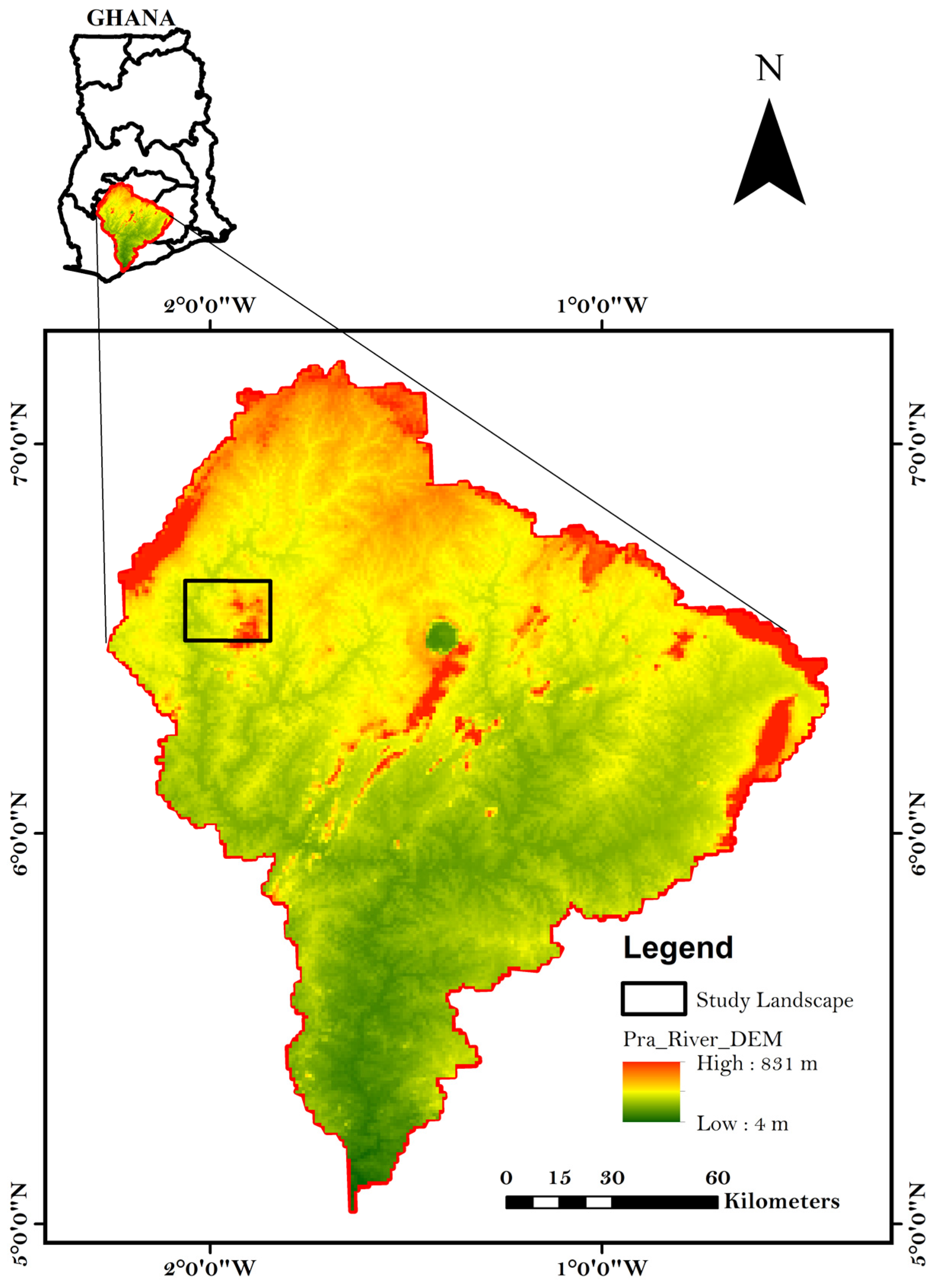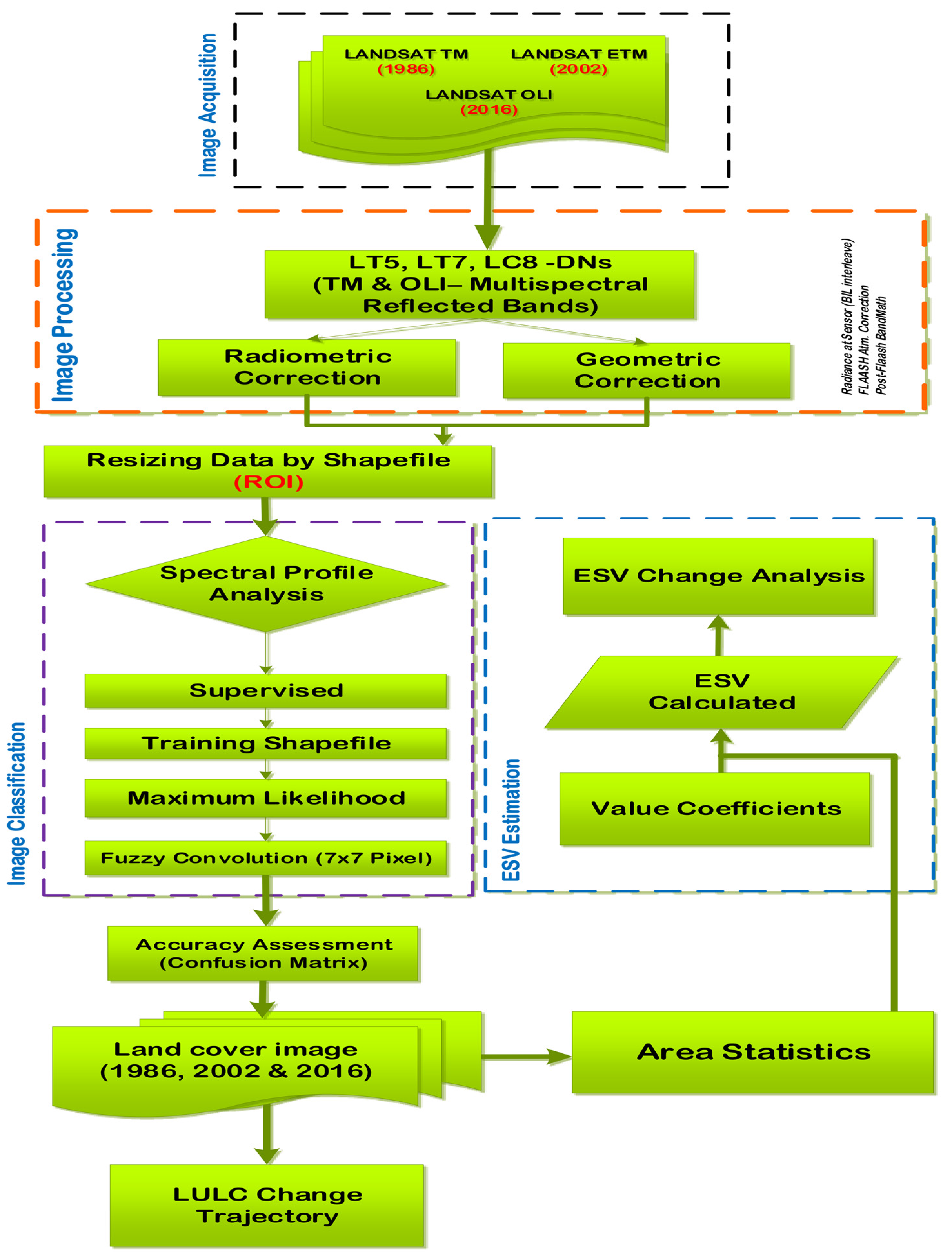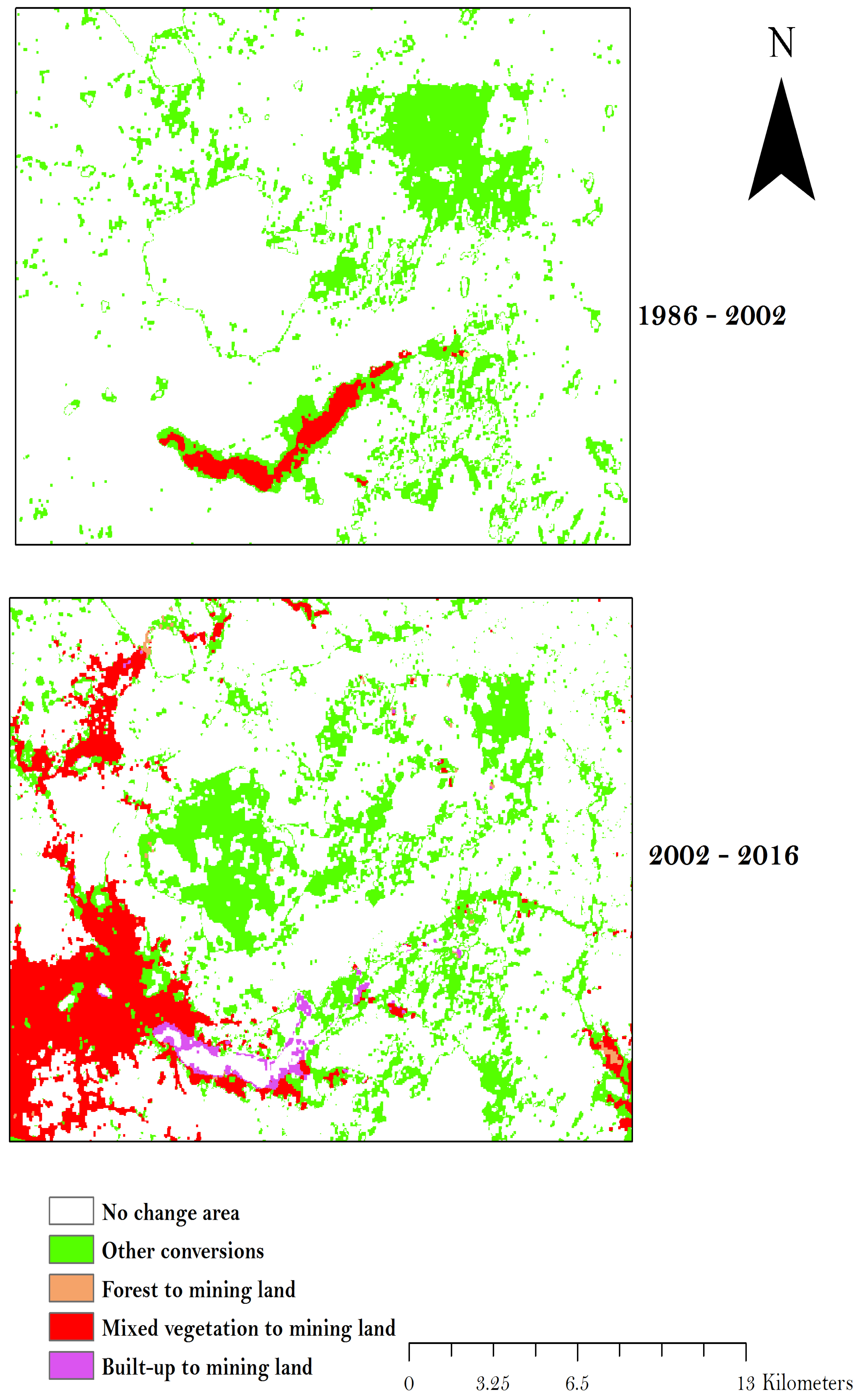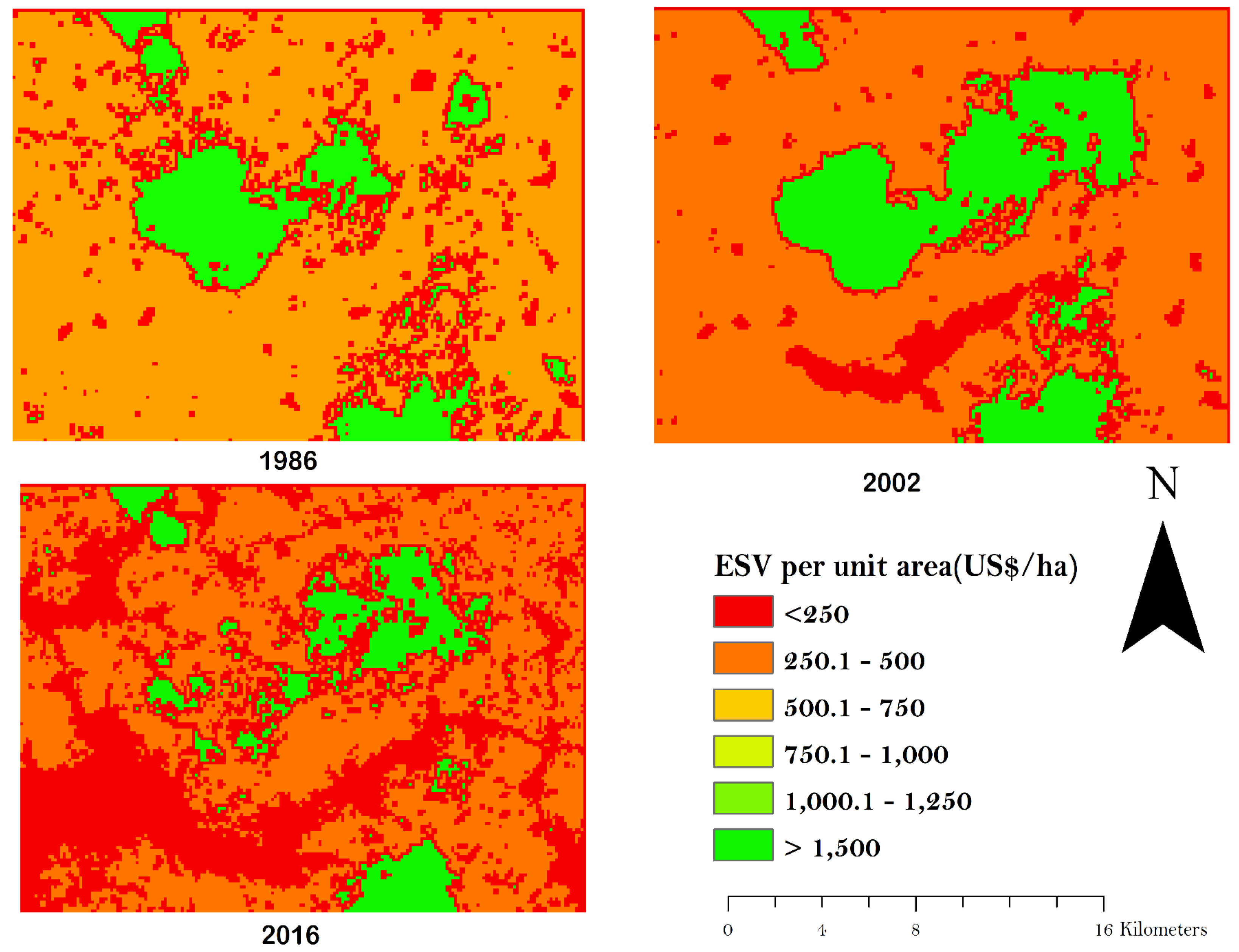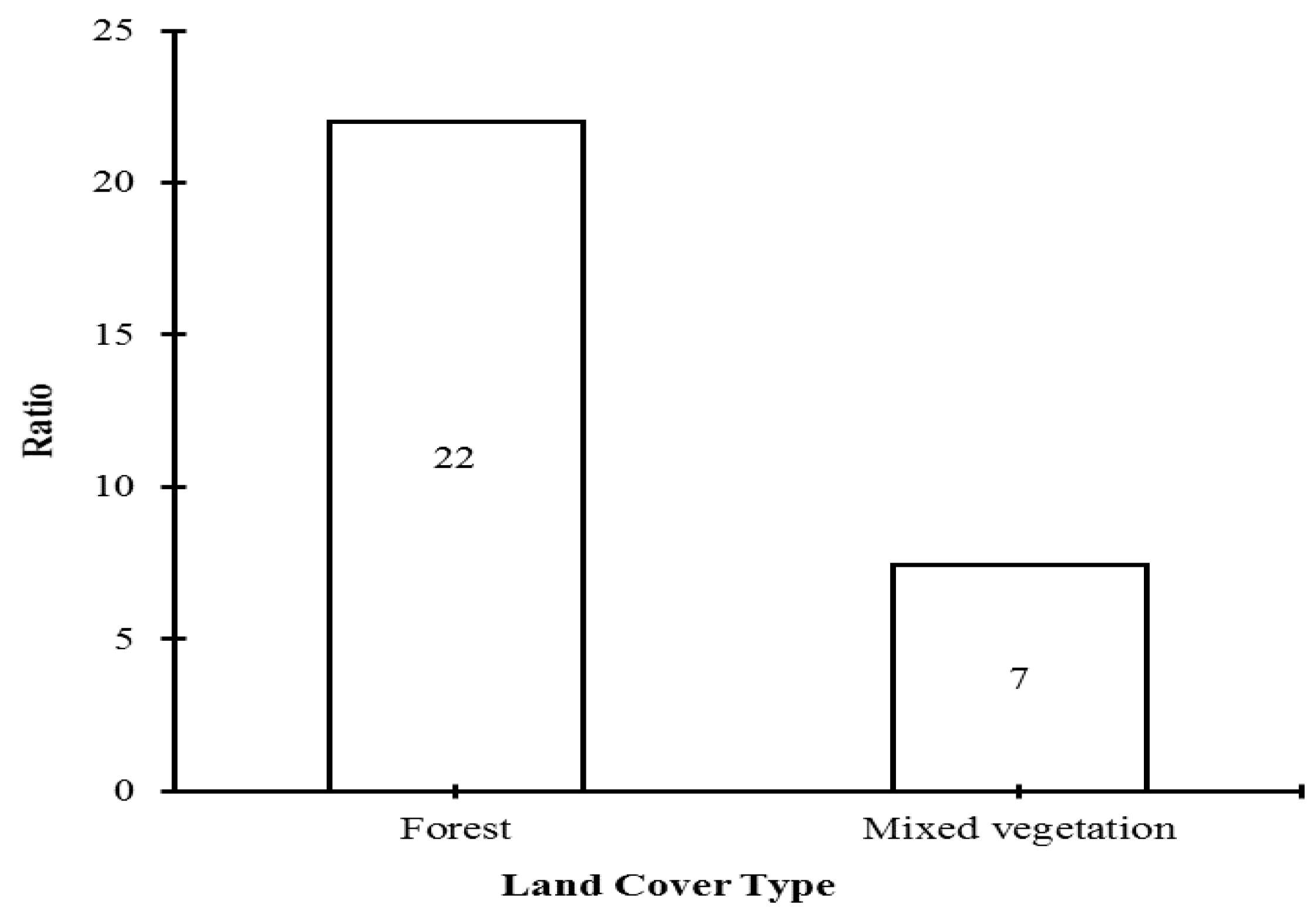1. Introduction
A sustained and fulfilled human life depends on the service provisions of the earth’s ecosystems [
1]. It has been widely recognised that the expansion of spatial extent of land uses shrinks the size and disrupts the composition of land covers (ecosystems), with a resultant consequence on the services their ecosystems deliver for human well-being [
1,
2]. Hence, the term trade-offs in land systems analysis. The millennium assessment group estimates that more than 60% of ecosystem services are traded-off to satisfy human’s demands. Therefore, the ability of a nation to strike a balance between human needs and ecological capacity revolves around making “sound decisions” on the use of these environmental resources [
3]. Usually, nations are confronted with options to “extract” or “not extract” resources from productive lands. Yet, before a decision is made, they ultimately weigh the inherent trade-offs between satisfying immediate human needs and the unintended ecosystem consequences based on societal values [
2]. Therefore, valuing the ecosystem services would be important in order to guide such decisions [
4]. The study adopted the classical economic term a “forgone alternative” [
5] to represent the value of the ecosystem is reduced in quantity and/or quality in order to use the land for mining activities.
Similarly, the Government of Ghana (GoG) has decided to mine its mineral resources at the expense of the ecological components of the land. The decision led to the enactment of the Provisional National Defense Council Law (PNDCL) 218 (1989) to legalise the small-scale mining sector, due to the perceived immense direct gross value additions (GVA) and livelihood uplift. In terms of these contributions, the PricewaterhouseCoopers (PwC) ranks Ghana (8% of GDP) as second to Papua New Guinea (15% of GDP) as a gold producing nation whose economy is greatly influenced by gold resource dynamics [
6]. From the biophysical point of view, however, gold extraction leaves series of patches within the ecological system leading to a discontinuity in not only the ecological system but also the land system as a whole. The impacts sometimes may result in the severe impairment of the ecosystems of the affected lands [
7]; many of which may be unable to revert to their pre-disturbed state without being assisted [
8].
Currently, gold extraction activities have become widespread and more attractive because the nation wants to earn more foreign exchange for increasing infrastructure and development projects [
9]. The pressures on landscapes to serve these extractive uses (extrinsic trade-offs) have been on the ascendency and are expected to increase significantly in the next decades. Moreover, the intensity and scale of extraction of gold influence the ecological integrity of mined land [
10]. Taking no notice of these ecosystems threats would have significant negative implications on Sustainable Development Agendas (SDGs). These tremendous pressures from gold mineral mining in Ghana are linked to both small-scale and large-scale gold businesses [
11]. For instance, the pressures their activities is seen mostly in the destruction of farmlands, protected forest ecosystems, etc. [
12]. To ensure sustainability, management decisions may be based on trade-offs analysis in order to harmonise the ecological environment and industrial environment. Yet, there is limited empirical evidence on the direction of land conversion and ecological degradation. These issues have made sustainable land management activities to be ineffective in Ghana [
13]. These instances require studies that provide evidence to help offset and steer the Ghanaian mineable landscapes and the world at large such as the assessment of the value of gold mining activities and ecological components.
Indeed, many environmental monitoring studies have emphasised the performance of remote sensing methods for differentiating and identifying land use categories as well as changed patterns at diverse scales. Not only are researchers able to quantify the ecological degradation in space but also in time by remote sensing techniques. Regarding the impacts of technological loads in Ghana, many types of research have provided evidence that there are important ecosystem services loss due to farmland degradation and deforestation [
10,
14,
15,
16]. Again, Snapir et al. extensively mapped and discussed the spatial-temporal dynamics of “galamsey” activities. Their work revealed that the activity has tripled within four (4) years, from 2011 to 2015 and have directly encroached major forest reserves [
17]. However, to be informed about the size and extent of degradation is inadequate when it comes to representing these degradation situation for policy implication purposes, yet, little has been ushered into quantifying the ecosystem services such as the food production, air purification, carbon storage, etc., that are lost due to these technological loads. The present study uses a remote sensing-based ES valuation approaches to quantify the value and appraises the ecosystem services loss due to small-scale mining in Ghana. It is essential to ascertain the status of ecosystems (e.g., [
18]). Quantifying the monetary value of ecosystem services, however, is important to work out the optimum mixes of ecosystem services [
19]. If the costs and benefits to society by undertaking mining activities are estimated, it would provide an idea of the trade-offs between the mixes of ecosystem services and the economic needs of Ghana. A detailed understanding of the forgone values of a typical mining area is, thus, pertinent for decision makers (i.e., environment protection agencies, forestry commission, other stakeholders and/or interest groups) to instate tangible, but prudent, resource conservation measures. For instance, it will support their decisions on compensation payments [
20] and regulation of the post-mining rehabilitation bench fees.
The trade-off analysis used in this study followed a renowned model propounded by Constanza et al. [
4]. The model has been applied in diverse study sites and research fields. For instance, Kreuter et al. [
21] estimated the monetary value of ecosystem services in San Antonio—USA (from 1976 to 1991) and found a significant decline of Ecosystem Service Value (
ESV) of 4% per annum. Wang et al. [
22] presented some interesting findings on freshwater wetlands in China. Their work revealed that waste treatment service, water supply service and disturbance regulation service accounted for more than 60% to the total ecological values decline due to watershed degradation. Kubiszewski et al. [
23] used benefit transfer methods to estimate that over 47% of the benefits of ecosystems services accrue to the people living inside the boundaries of Bhutan. Using a typical small-scale gold mining landscape as a case, we explored and quantified the impacts the small-scale mining laws (PNDCL 218) on the land use dynamics using remote sensing-based approaches. Specifically (1) determined the trade-off patterns of land uses along a multi-temporal scale; (2) examined and compared the changes in the ecosystem service values achieved for the early- and late-PNDCL periods.
5. Conclusions
Ghana’s economic development relies largely on gold industry, but the ecological cost is very high particularly from the small-scale sector. The study at hand gives an account of the ecological pressures from the small-scale gold mining sectors. These pressures were measured by considering the ecosystems (land cover types), which are affected by the small-scale mining. Thus, the extent and the magnitude of the ESV associated with the land cover that was stripped to make available the small-scale gold mining, as well as the sustainability of two production systems were estimated. Historical data covering a period of 30 years (1986–2016) was used in this study. In general, the land use types of the study landscape were distinctively dynamic from 1986 to 2002 to 2016. The expanse of mining land use increased from 0.9% in 1986 to 11.8% in 2016. However, the annual growth rate during the early-PNDCL of 4.1% was significantly lower compared to the late-PNDCL of 47.5%. The study also estimated and compared the trade-off regions to the unchanged regions by using a per-pixel change trajectory matrix. A considerable percentage of the trade-off areas was associated with small-scale gold mining. Comparatively, greater mining-related land use dynamics, which include the expansion of mining land use patches and the formation of new ones, were observed during the late-PNDCL period (2002–2016; 36.3%) compared to the early-PNDCL period (1986–2002; 8.4%). In monetary term, the small-scale gold mining was responsible for about 1.43 million US$ of the 3.06 million US$ net decline of the ecological services of the landscape from 1986 to 2016. The mining activities encroaching forest and mixed vegetation accounted for 0.06 and 1.37 million US$ of the net decline of the ESV of the study area. The study delved only into the spatiotemporal dimension the mining land use change of the study landscape, but when supplemented with previous scholarly works, it appears the laws are enacted but fail to check and sanction defaulters. The study would contribute to better understanding of the variation in ESVs, their dynamics, and the evolution of small-scale mining. It has provided the scientific basis for informing land management and environmental protection policies.
